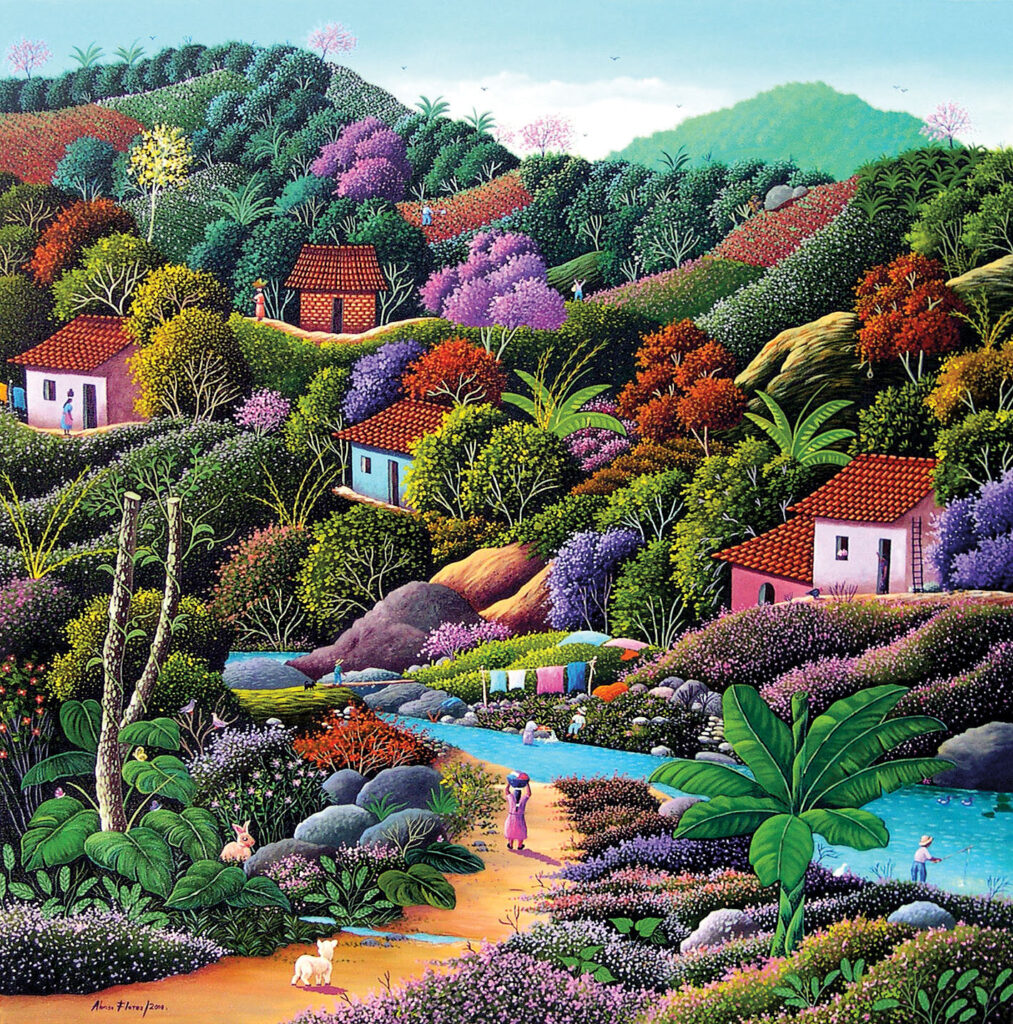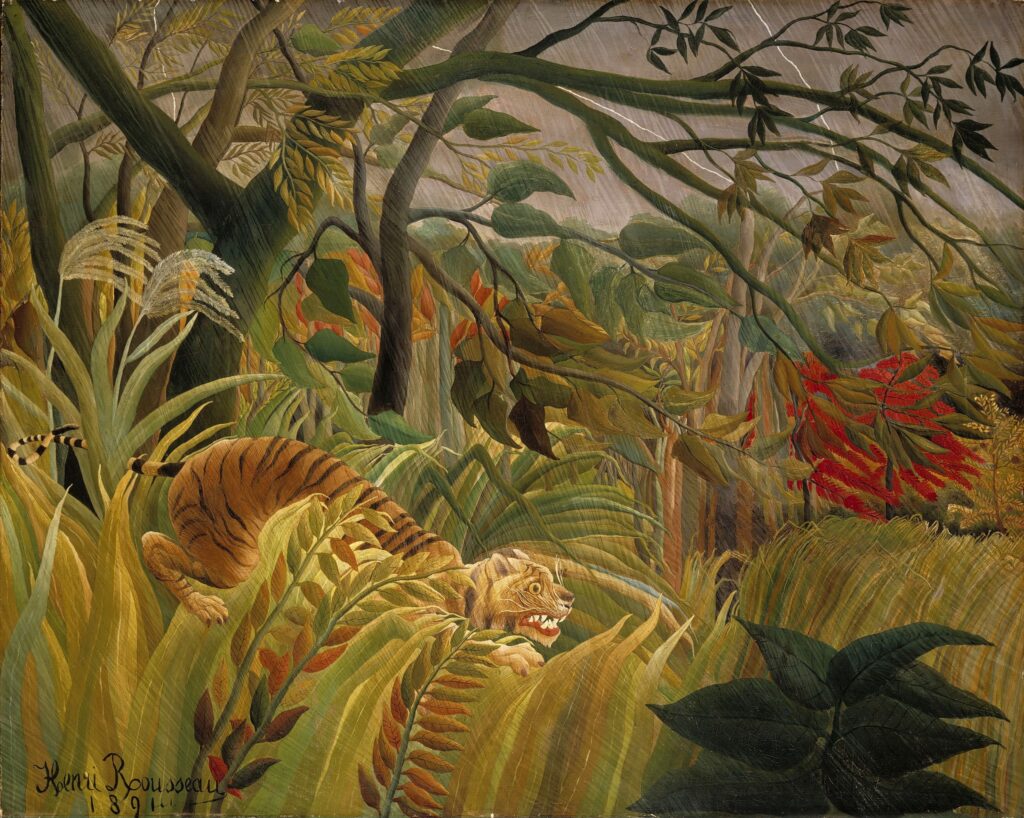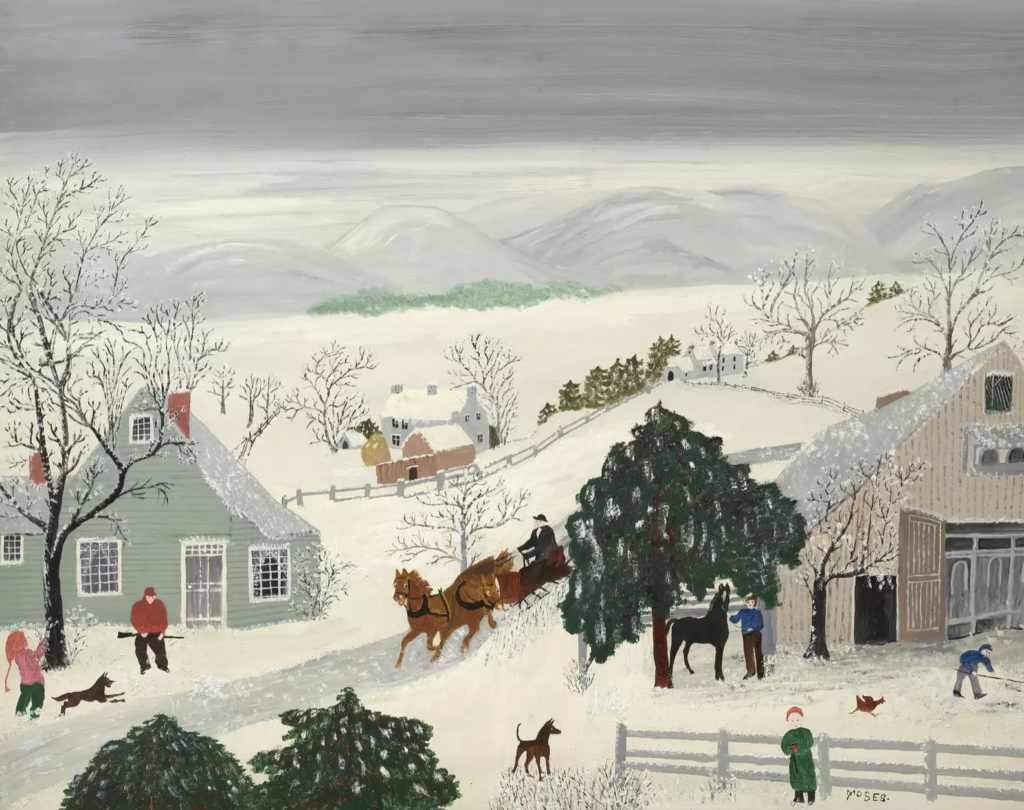Naïve art: between art and craft
written by art historian & curator
Naïve art is a controversial artistic genre situated at the border between folk art, outsider art, or provincial art. Officially defined as visual creation belonging to individuals lacking formal education in fine arts, naïve art reflects an aesthetics decorative and simple, similar to children’s drawings. Folk art borrows from the naïve visuals but it’s mainly inspired by practical objects and popular lifestyles. Outsider art also has some common aesthetics with folk and naïve art, but its subjects have little to do with the mainstream world. Naïve art is easy to recognise through its flat and non-realistic perspective and modified anatomical features.
Join our free online talks:
Although it may differ in style and technique from many academic art forms, naïve art possesses its own unique aesthetic and creative expression. Naïve art reflects the imagination and personal experiences of the artists who create it. It often captures a sense of innocence, authenticity, and spontaneity that can resonate with viewers. Naïve art has gained recognition and appreciation within the art world, and many museums and galleries exhibit and collect works naïve of artists. While this matter is disputed according to conventional criteria, this art genre is widely recognised and valued as a legitimate form of artistic expression.
Origins of Naïve Art
The beginning of naïve art can be traced to the artistic revolution that overtook France in the 19th century. Although all artists pass through a creational phase that includes naïve or folk features, the emergence of naïve art as a recognised art movement can be attributed to the early 20th century. The appeal of naïve art lies in its departure from academic norms and the freedom it provides for self-expression. Naïve art drew inspiration from folk and indigenous art traditions that celebrated simplicity, storytelling, and community. Also known as “primitive” art, this genre is mainly characterised by its untrained style. Below are some key considerations about naïve art.

Simplicity. This genre is characterized by its simplistic style. Artists often use basic shapes, bright colors, and straightforward compositions.
Lack of Perspective. Naïve artists typically do not employ traditional techniques of perspective or depth. Their works often depict objects and figures in a flat, two-dimensional manner.
Bold and Vibrant Colors. The genre tends to feature bold and vibrant colors. Artists use strong primary colors and vivid hues, often without adhering to realistic color representation.
Subject Matter. Naïve art often focuses on everyday life, rural scenes, landscapes, and ordinary people. Artists frequently depict familiar objects, animals, and people from their immediate environment.
Simplified Forms and Proportions. Artists simplify and stylize forms, reducing them to their basic elements. Figures and objects may appear exaggerated or distorted, emphasizing their essential characteristics.
Lack of Formal Training. Naïve artists typically have little or no formal artistic training. They approach art with a fresh perspective and an intuitive, uninhibited style.
Joyful and Optimistic Themes. Often naïve art conveys a sense of joy, innocence, and optimism. Artists depict cheerful scenes, celebrations, and everyday activities with a positive outlook.
Narrative Quality. Most of the time, naive art tells a story or conveys a narrative. Artists may include symbolic elements or visual clues to communicate their intended message or theme.
However, contemporary artists use naïve style consciously, becoming the representants of what is known as ”pseudo naïve” or ”faux naïve”. Their art describes an artwork created in a more imitative mode. Today almost all artists have access to some sort of training in arts given the extensive use of the internet and the existence of so many courses and tutorials. Thus, truly naïve artists are unlikely to exist.
Le Douanier Rousseau
Henri Rousseau, also known as Le Douanier Rousseau, was a French artist who is often associated with the Naïve art movement. Rousseau’s artistic style aligned with the principles of naïve art. He was largely self-taught and had no formal training in art. This contributed to the unique and unconventional nature of his work. His paintings often depicted lush landscapes, exotic animals, and imaginative scenes, which he created with meticulous attention to detail.

The Iconic painting “Tiger in a Tropical Storm (Surprised!)” was completed by Henri Rousseau in 1891. Today the artwork is being exhibited in the National Gallery in London. In the center of the composition, a fearsome tiger leaps through the undergrowth, its eyes wide open with a startled expression. The tiger’s powerful presence dominates the canvas, capturing the viewer’s attention. Rousseau masterfully uses color, composition, and brushwork to convey a sense of movement, tension, and the untamed wildness of the jungle. The rich greens and blues of the foliage and sky contrast with the vibrant orange and black stripes of the tiger, creating a visually striking image.
The title “Surprised!” suggests that the tiger has been caught off guard by the storm or an unexpected event, emphasising the wild and unpredictable nature of the jungle. Rousseau’s portrayal of the tiger’s intense gaze and agitated body language adds to the feeling of suspense and imminent action. Rousseau’s “Tiger in a Tropical Storm” is considered a prime example of his signature style. Although he had never visited a tropical jungle and had no direct experience with tigers, Rousseau relied on his imagination, botanical illustrations, and visits to botanical gardens to create his lush and exotic scenes. The painting is significant for its visual impact and role in shaping Rousseau’s reputation as a unique and visionary artist. Despite initial criticism, “Tiger in a Tropical Storm” remains an iconic work that exemplifies Rousseau’s imaginative approach to art and his ability to evoke a sense of wonder and mystery.

Rousseau’s artistic career gained recognition and popularity during the late 19th and early 20th centuries. Although initially met with skepticism from the art establishment, his bold and distinctive style eventually earned him acclaim as one of the pioneers of naïve art. His works were admired for their charm, originality, and the sense of wonder they conveyed. Rousseau’s contributions to naïve art were significant in shaping the movement and influencing subsequent generations of artists. His ability to capture a sense of innocence and childlike imagination in his paintings resonated with audiences. He became an inspiration to other artists to explore similar themes and styles. Rousseau’s work continues to be celebrated for its simplicity, naivety, and its rejection of conventional artistic norms.
Jean Dubuffet and His Art Brut
Jean Dubuffet is a French painter and sculptor known for his ”raw art”. He coined a specific term, Art Brut, which, according to Tate Modern is ”the work of the mentally ill, prisoners, children, and primitive artists was the raw expression of a vision or emotions, untrammelled by convention”.
Dubuffet was deeply interested in the art created by individuals who were not formally trained artists and who often had little or no exposure to the art world. He sought to celebrate the spontaneity and unfiltered expression found in the work of these creators. Dubuffet valued the raw, untamed creativity that emerged from unconventional sources.

Dubuffet’s artistic style was influenced by his appreciation for naïve and outsider art. He embraced an authentic and unrefined approach to his work, often employing bold, gestural brushwork and using unconventional materials. His paintings and sculptures often exhibited simplicity, directness of expression, and a rejection of traditional artistic techniques and conventions.
Dubuffet’s contributions to the art world were not only in his artistic practice but also in his efforts to promote and collect the work of outsider artists. He amassed an extensive collection of art brut and championed the recognition and appreciation of these unconventional artistic voices.
Overall, while Jean Dubuffet cannot be classified strictly as a naïve artist, his embrace of art brut and his exploration of unconventional artistic expressions align him with the spirit of naïve art. He played a significant role in bringing attention to the art of self-taught, outsider artists and challenging the boundaries of the art world.

Several notable museums around the world exhibit naïve art showcasing the works of self-taught and outsider artists. Musée d’Art Naïf – located in Nice, France, is entirely dedicated to naïve art. It houses a significant collection of works by naïve artists from around the world, including Henri Rousseau, Séraphine Louis, and Grandma Moses. La Fabuloserie is a unique museum in Dicy, France, known for its collection of art brut and naïve art. It features works by self-taught artists and showcases imaginative and unconventional creations. Collection de l’Art Brut was founded by Jean Dubuffet in Lausanne. It is one of the most renowned museums dedicated to art brut. While it primarily focuses on outsider art, it often includes naïve art in its exhibitions.
American Visionary Art Museum in Baltimore, Maryland, celebrates self-taught and visionary artists from various backgrounds. It exhibits a wide range of unconventional art forms, including naïve art, outsider art, and folk art. The Museum of Naïve and Marginal Art is located in Jagodina, Serbia, and showcases naïve and marginal art. It houses an extensive collection of works by both Serbian and international naïve artists. These museums provide platforms for the recognition, preservation, and celebration of naïve art. They offer visitors the opportunity to explore the unique perspectives and expressions of self-taught artists from around the world.
GET MORE FROM LEVEL


Leave a Reply